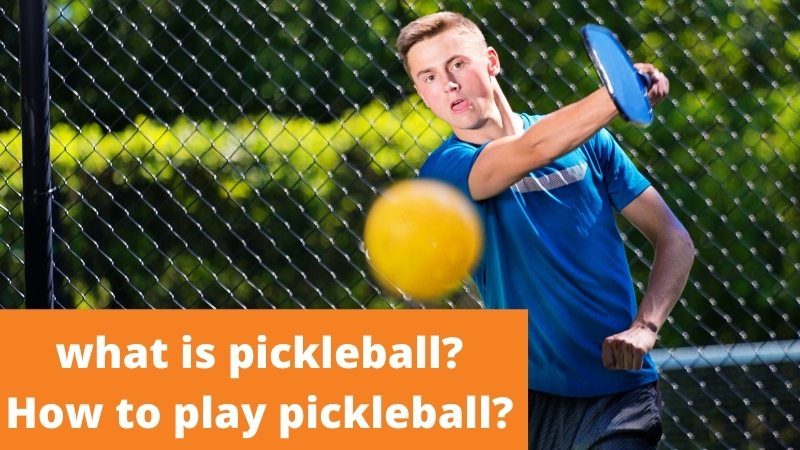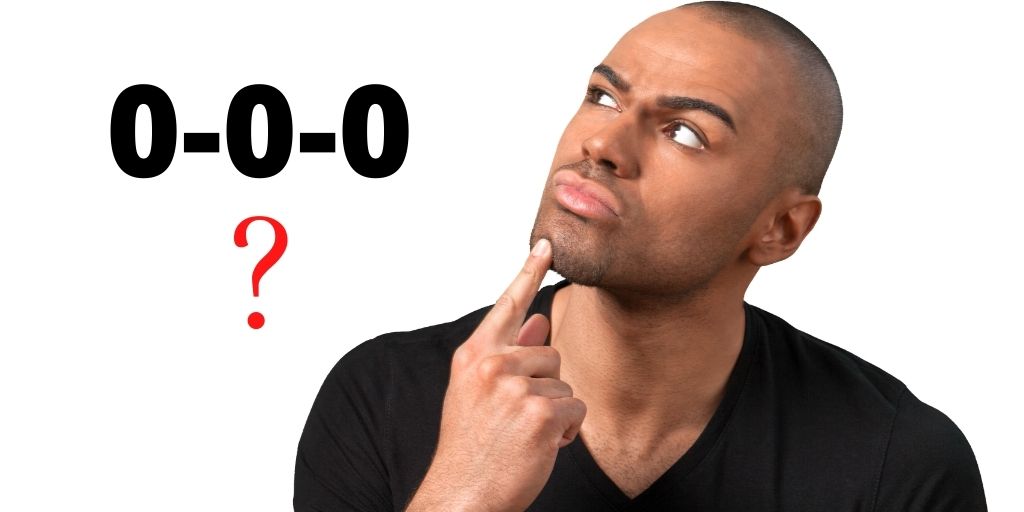As a beginner, you may think it’s simple to hold a pickleball paddle and hit the ball in your desired direction. But you’ve to know how to hold a pickleball paddle correctly, which takes time and skills to learn.
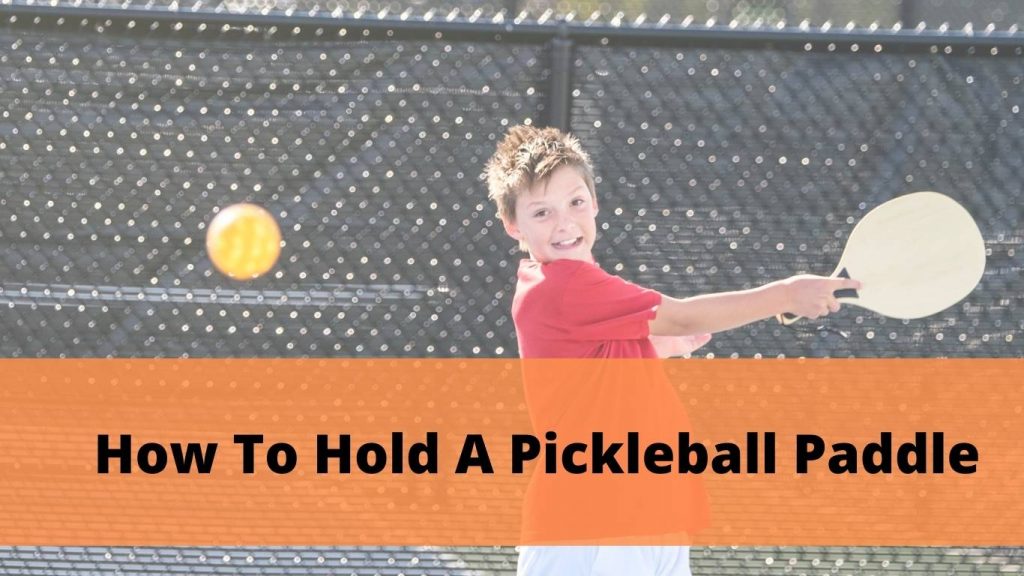
Pickleball paddles come in various shapes and designs to suit multiple play styles. You can make the most out of it until you know the proper way of holding a pickleball paddle.
Let’s learn the ideal method to hold a pickleball paddle and where you should keep your hands to hit the ball perfectly.
Read more ” Best pickleball paddle under $100 “
Learn the Grip First
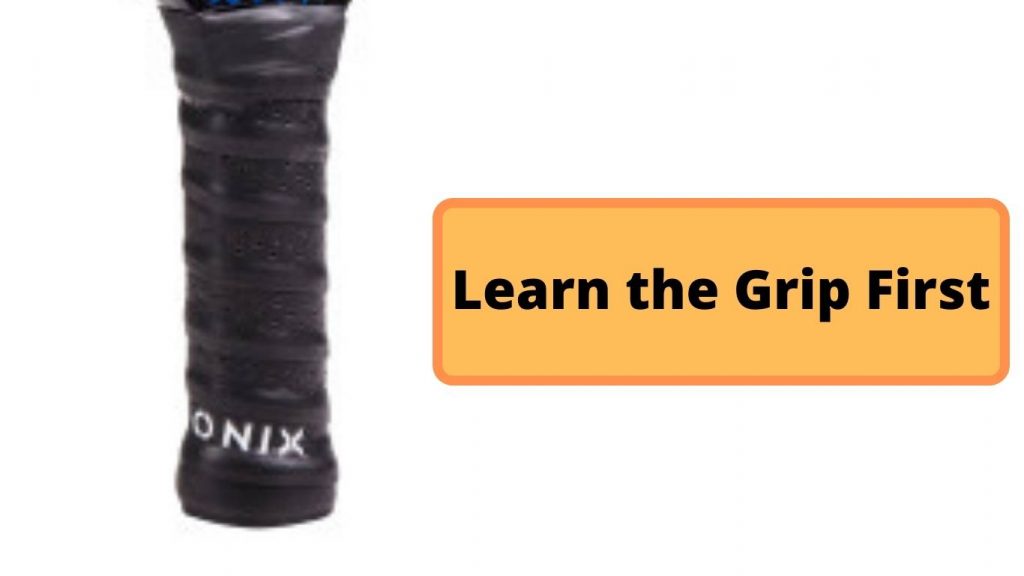
It doesn’t need any practice to hold a pickleball paddle randomly. But when you want to keep it in your hand appropriately, it’ll be slightly different.
Our different holding styles are also known as grip styles. Here’re different types of grips.
Continental Grip
One of the most common types of grip is continental grip. It’s like holding a hammer. If you prefer playing with the same number of forehands and backhands, this type of grip is an ideal option.
You can compare the continental grip to shaking hands. It has a ‘V’ shape while holding the paddle if you notice carefully.
Your performing action will be immense and convenient while keeping the paddle to 90 degrees direction in the ground. Holding your racquet in a continental grip means it will be in a straight position.
It’s one of the most sophisticated ways to hold paddles, especially when you quickly shift backhand to forehand. That’s why many professional players follow this grip style.
Though beginners will take time to learn the technique of using this grip style, they’ll surely like it.
Western or Semi-Western Grip
If you love to strike or hit sharply, a western or semi-western grip is the right choice. It’s mainly popular in tennis sports. Following this grip style means you keep your hand back at the flat area of the racquet.
People who love forehand strokes will love this type of grip. Additionally, anyone with no paddle sports experience will prefer this grip over others.
There’s a difference between western and semi-western grip. When you keep your forefinger to the base of the handle, it’s called a fully western grip.
On the contrary, it’ll be called semi-western grip if your forefinger is located in the handle position.
However, people who love backhand strokes won’t be benefitted from this grip style. You won’t get enough support to hit the ball since your wrist will face toward the net. But you can use a two-handed to utilize this shot.
Eastern Grip
An Eastern grip is a perfect choice to make if you want a grip style between forehand and backhand stroke. It’s especially popular among new players.
The grip style is perfect when you prefer an ideal compromise between two types of strokes.
Strong, Weak, And Neutral
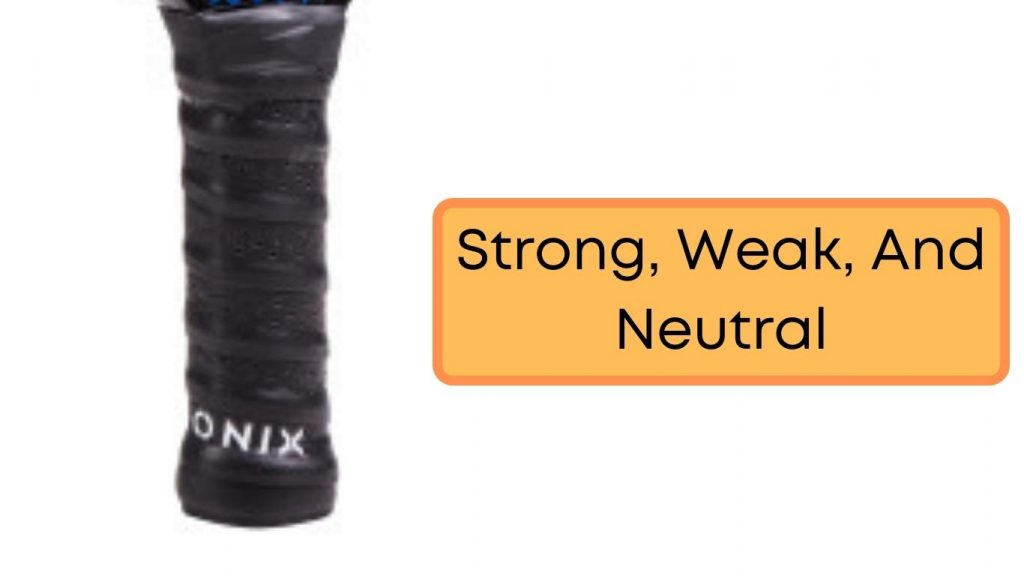
So, you’ve already learned different ways to hold pickleball paddles. However, the grip style you choose can be strong, weak, and neutral.
Neutral Grip
It’s a typical grip used by a lot of pickleball players. People use neutral grip when they don’t use other types.
So, why do players play with a neutral position most of the time? It allows them to play a large number of pickleball shots. Whether you want to play drives, dinks, backhand, or forehand, it’s perfect for all.
Strong Grip
Players use strong grip to play powerful or aggressive shots. After all, you can hit the vigorously without holding the handle tightly.
The grip is especially beneficial for overhead smashes and other powerful strokes. You keep your hands to the upper part of the grip area most of the time while playing with this grip style. It appears as a “V” position.
But don’t expect to use the grip for playing tricky shots like dinking. Your immense wrist action and aggressive power won’t allow you to play this shot.
Weak Grip
A weak grip is a less popular option in pickleball sports. Very few people use this grip as it isn’t adequate to play for tricky or powerful shots.
However, the grip might be a handy option to utilize spin shots and cuts sometimes, not always. But it needs practice. Playing it in the middle of the game may end up losing an important point.
Where Should You Hold The Pickleball Paddle?
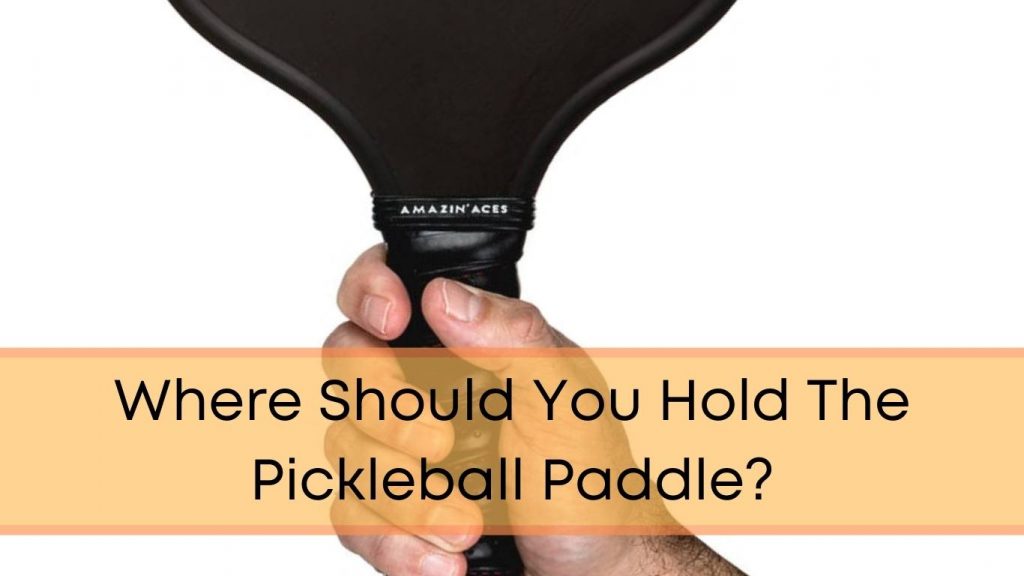
Different people prefer to hold the paddle on other spots. You’ll get a specific benefit for keeping your hand on a particular location.
Bottom of the handle
Many people prefer to keep their hand on the bottom of the handle to get extended reach. But most players do it as a way of their natural playing style.
Additionally, this holding approach can give a longer lever to hit the ball. So, you’ll get more power from it.
Top of the handle
Holding the pickleball handle close to the upper part gives players a shorter lever. Though this approach gives you more opportunity to control, you won’t get much power.
Some professional players described it as a ping-pong paddle. You can’t stick to this position always because you often hit powerful shots.
Top Tips For Holding A Pickleball Paddle
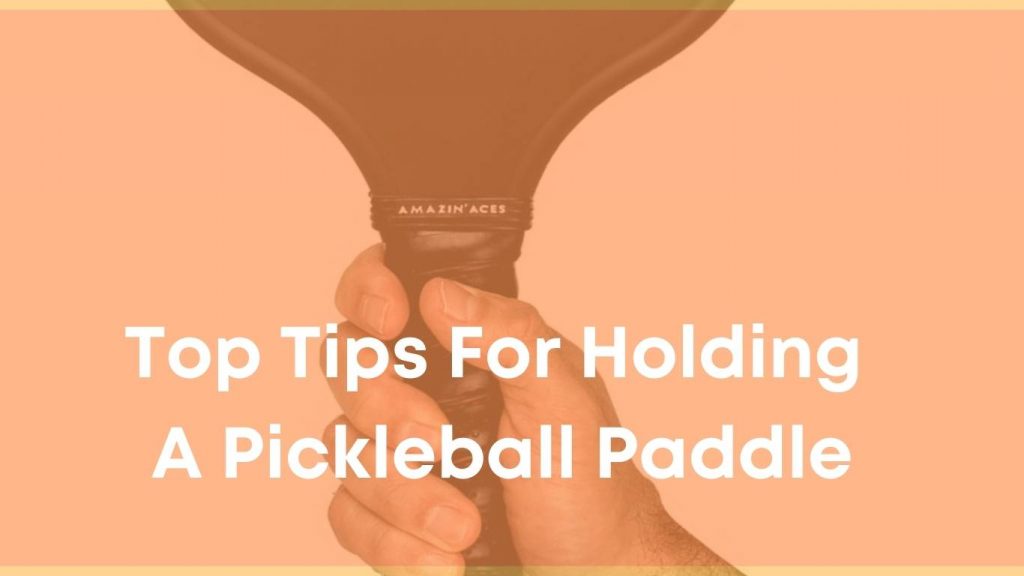
Holding the pickleball paddle in the right way is vital to make the most out of it according to your playability. Here’re some top tips for holding a pickleball paddle.
Switching Hands
Many professional players switch hands while playing the pickleball sport. Some of them do it so creatively that you won’t even notice.
But it needs practice, skills, and learning-from-mistakes approaches. After all, pickleball courts are small. You won’t get much time to change the paddle from one hand to another.
Additionally, you’ll have to use your weaker hand to control the ball. Sometimes, players may drop the paddle when exchanging the paddle between hands. It’s a challenging task due to limited time.
Finger On Surface
Do you have a habit of keeping your thumb finger on the paddle surface? Well, not only you, many ex-tennis players do it.
So, why do people keep one finger on the paddle surface? According to many pickleball players, it makes a deep connection between their brain and the finger.
Your action of orienting the ball becomes easier. Thus, you can play your desired stroke according to your plan.
Not just a single finger; some players keep more than one finger, including the thumb finger on the paddle surface.
It helps them get impressive control and stability to use the paddle in various directions and angles.
Hence, your experience with stroke play will be more delightful. But being a little bit cautious is necessary. Otherwise, you may end up hitting your finger when the ball touches the paddle surface.
Why Is A Dedicated Grip Important?
A dedicated grip is important when you want to get the best stroke from your pickleball gameplay.
And you can’t get a reliable grip without holding the paddle in the first place. After all, your playing style depends on how you hold the paddle.
Whether you want to play dinks, volleys, or random shorts, a decent grip provides excellent results in most playing conditions.
Additionally, putting a spin on your pickleball surface requires you to contact the ball at the correct zone. Otherwise, you can’t generate spin.
So, now you understand the importance of a good grip, which will affect your gameplay and help you to win the match.
Different brands provide different grip technology in their pickleball paddles. Their unique grip lets you hold the paddle firmly without experiencing slippery issues.
Choosing an approved or certified paddle is a solid rule of thumb. They’ve better quality to hold them on hands naturally. You’ll feel comfortable holding them while giving your best efforts to play your natural game.
Thus, regardless of the gaming style you have, the grip is essential for singles and doubles pickleball games. Your primary focus should be choosing a pickleball paddle with a good grip that matches your playing style.
Don’t Overlook Your Ready Position
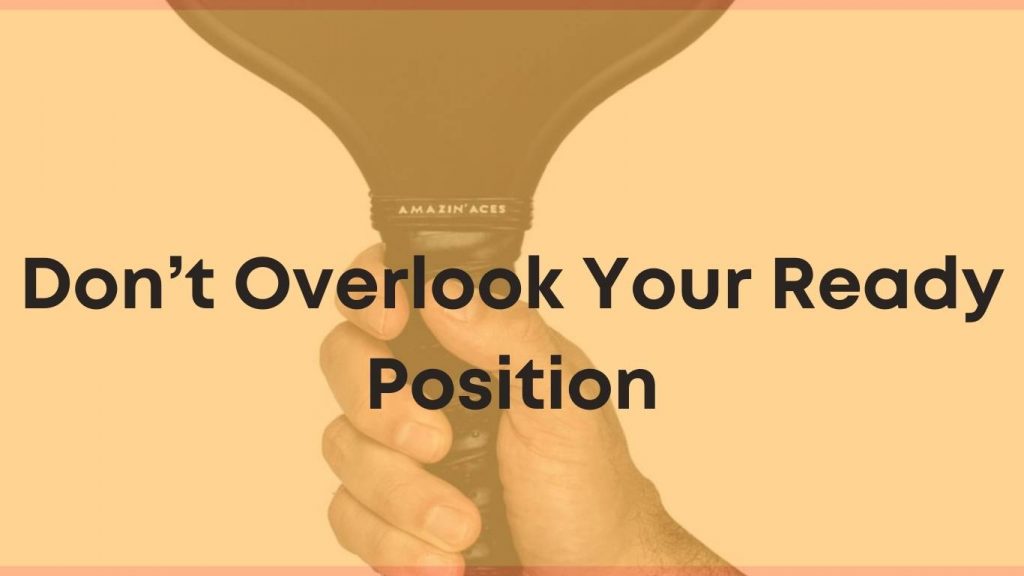
Being in the ready position is always essential in the pickleball game, especially for the newbies.
But ready positions vary. A position that works for you may not work for someone. Finding the appropriate ready position is important.
Some people may become comfortable standing in a 12 o’clock position, while few may benefit from a 9 o’clock ready position.
However, many pickleball experts recommend standing in the 10 o’clock position. It appears natural and comfortable.
Serving or returning forehand and backhand ball will be easy-going in that position. This makes you balanced. Also, you’ll develop a deeper connection with the pickleball paddle.
Wrapping Up
No doubt, your skills, and experience are important to win your pickleball game. But that doesn’t mean you’ll overlook your pickleball grip.
Knowing how to hold a pickleball paddle is crucial, especially for beginners. Unless you hold the paddle comfortably and naturally on your hands, it’s hard to bring your inner best and win the gameplay.

